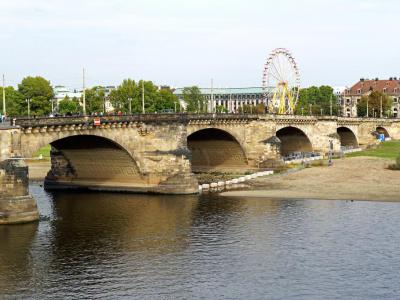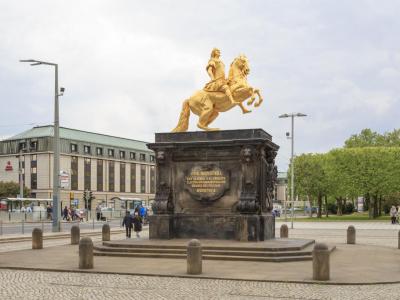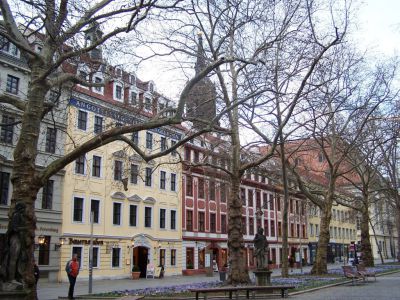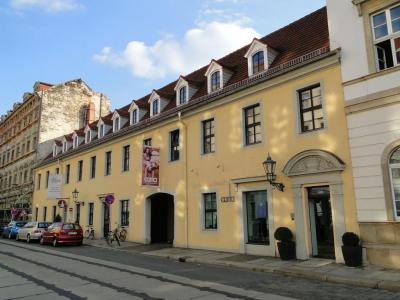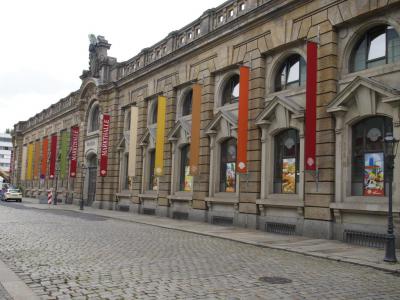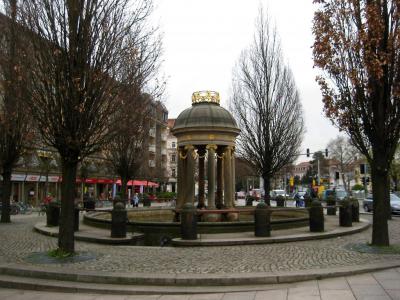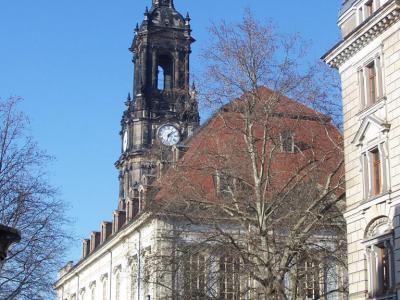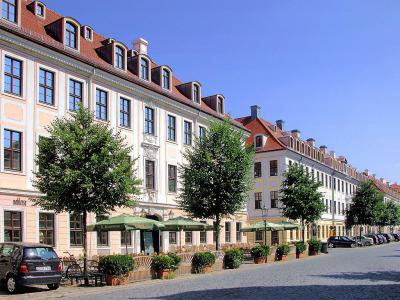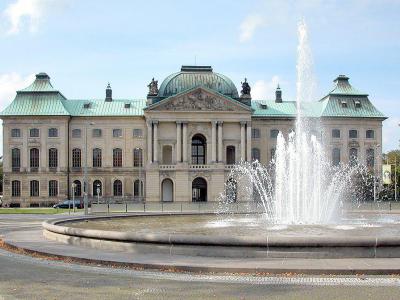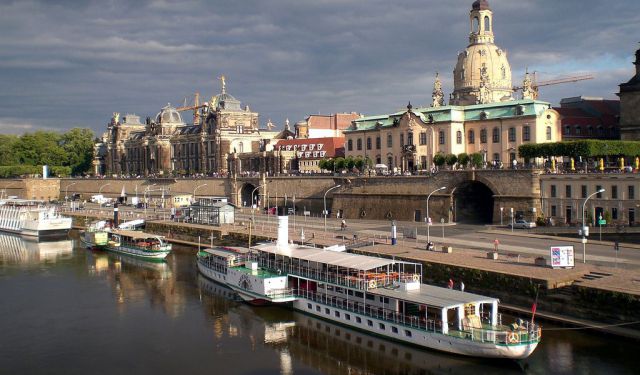Dresden New Town Walk (Self Guided), Dresden
The Neustadt (New Town) of Dresden is a central district located on the north bank of the Elbe. Despite the name, this part of the city is not at all new and has been inhabited for as long as the Old Town on the opposite side of the river. Its “novelty” derives from "Neue Königliche Stadt" (New Royal Town), which is the title given to the area, formerly the district of Altendresden, after its Baroque-style reconstruction, following a fire, in 1732.
The latter produced a wealth of elegant architecture, much of which, luckily, had survived the wartime destruction of the 1940s. A good number of Dresden's historical buildings are found around Königstrasse (King's Street), which is a part of the so-called Innere Neustadt (Inner New Town).
A prelude to the Innere Neustadt is the Neustädter Markt – redesigned during GDR times in style of a “socialist” city center of the 1970s – dominated by the equestrian statue of king August the Strong (known locally as the "Golden Horseman"). Beyond the statue starts Hauptstrasse, the main street of the historical quarter.
There are four bridges crossing the Elbe within the Neustadt, including the historic Augustusbrücke (Augustus' Bridge). The streets leading towards them converge at Albertplatz, the central square and traffic junction of the New Town. Lining the river banks here are the government buildings of the so-called “government quarter” and the Japanisches Palais (Japanese Palace), home to the State Museum of Ethnology. Also here is the Dreikönigskirche (Three Kings' Church), destroyed and rebuilt several times throughout its history – the former seat of the Saxon parliament, from 1990 to 1993.
If you wish to connect with Dresden’s New Town and be mesmerized by its cultural attractions, take this self-guided walking tour.
The latter produced a wealth of elegant architecture, much of which, luckily, had survived the wartime destruction of the 1940s. A good number of Dresden's historical buildings are found around Königstrasse (King's Street), which is a part of the so-called Innere Neustadt (Inner New Town).
A prelude to the Innere Neustadt is the Neustädter Markt – redesigned during GDR times in style of a “socialist” city center of the 1970s – dominated by the equestrian statue of king August the Strong (known locally as the "Golden Horseman"). Beyond the statue starts Hauptstrasse, the main street of the historical quarter.
There are four bridges crossing the Elbe within the Neustadt, including the historic Augustusbrücke (Augustus' Bridge). The streets leading towards them converge at Albertplatz, the central square and traffic junction of the New Town. Lining the river banks here are the government buildings of the so-called “government quarter” and the Japanisches Palais (Japanese Palace), home to the State Museum of Ethnology. Also here is the Dreikönigskirche (Three Kings' Church), destroyed and rebuilt several times throughout its history – the former seat of the Saxon parliament, from 1990 to 1993.
If you wish to connect with Dresden’s New Town and be mesmerized by its cultural attractions, take this self-guided walking tour.
How it works: Download the app "GPSmyCity: Walks in 1K+ Cities" from Apple App Store or Google Play Store to your mobile phone or tablet. The app turns your mobile device into a personal tour guide and its built-in GPS navigation functions guide you from one tour stop to next. The app works offline, so no data plan is needed when traveling abroad.
Dresden New Town Walk Map
Guide Name: Dresden New Town Walk
Guide Location: Germany » Dresden (See other walking tours in Dresden)
Guide Type: Self-guided Walking Tour (Sightseeing)
# of Attractions: 9
Tour Duration: 1 Hour(s)
Travel Distance: 2.2 Km or 1.4 Miles
Author: vickyc
Sight(s) Featured in This Guide:
Guide Location: Germany » Dresden (See other walking tours in Dresden)
Guide Type: Self-guided Walking Tour (Sightseeing)
# of Attractions: 9
Tour Duration: 1 Hour(s)
Travel Distance: 2.2 Km or 1.4 Miles
Author: vickyc
Sight(s) Featured in This Guide:
- Augustusbrücke (Augustus Bridge)
- Neustadter Markt (New Town Market)
- Hauptstrasse (Head Street)
- Heinrichstrasse (Heinrich Street)
- Neustädter Markthalle (New Town Market Hall)
- Albertplat (Albert Square)
- Dreikönigskirche (Three Kings' Church)
- Königstrasse (King Street)
- Japanese Palace
1) Augustusbrücke (Augustus Bridge)
One of the most famous bridges north of the Alps, the Augustbrucke crosses the River Elbe to connect Dresden Neustadt on the right bank of the River to the historic part of Dresden on the left bank. The bridge was named after Elector Augustus the Strong and renamed Georgi Dimitrov Bridge when Dresden formed part of the German Democratic Republic.
The earliest record of a bridge that later became the Augustusbrucke was a wooden bridge in 1275. Later a stone bridge was constructed with 25 stone pillars in 1287. It was one of the longest bridges in Germany and connected major trade routes. The tolls collected at the customs house near the bridge was a major source of revenue for the Saxon Wettin rulers.
Augustus the Strong, who reigned during the golden age of Dresden, commissioned a new bridge because the old structure was unable to sustain the increased traffic that crossed the Elbe. The bridge was constructed by Council master mason, Johann Gottfried Fehre between 1727 and 1731. Architect Mathew Daniel Popplemann designed a curved structure, 402 meters long with 18 pillars. In 1845, the bridge collapsed because of the flooding of the Elbe and was constructed again by Wilhelm Kreis and Hermann Burdock.
Augustusbrucke suffered extensive damage during the 1945 Dresden bombings and was later lovingly restored to its former glory. Visitors can get a spectacular view of the River Elbe and both sides of Dresden while taking a stroll across the bridge.
The earliest record of a bridge that later became the Augustusbrucke was a wooden bridge in 1275. Later a stone bridge was constructed with 25 stone pillars in 1287. It was one of the longest bridges in Germany and connected major trade routes. The tolls collected at the customs house near the bridge was a major source of revenue for the Saxon Wettin rulers.
Augustus the Strong, who reigned during the golden age of Dresden, commissioned a new bridge because the old structure was unable to sustain the increased traffic that crossed the Elbe. The bridge was constructed by Council master mason, Johann Gottfried Fehre between 1727 and 1731. Architect Mathew Daniel Popplemann designed a curved structure, 402 meters long with 18 pillars. In 1845, the bridge collapsed because of the flooding of the Elbe and was constructed again by Wilhelm Kreis and Hermann Burdock.
Augustusbrucke suffered extensive damage during the 1945 Dresden bombings and was later lovingly restored to its former glory. Visitors can get a spectacular view of the River Elbe and both sides of Dresden while taking a stroll across the bridge.
2) Neustadter Markt (New Town Market)
The New Town Market (Neustädter Markt), located in the Inner Neustadt district of Dresden, boasts a rich history and cultural significance. This square, likely established before 1200 as a village square for a Slavic settlement in what later became Altendresden, has evolved significantly over the centuries.
The square is most renowned for its landmark, the "Golden Rider," an equestrian statue of August the Strong. Created by Ludwig Wiedemann and commissioned by August III, the son of August the Strong, this statue was cast in 1734 and is an iconic representation of the Elector dressed as a Roman emperor. This impressive sculpture, mounted on a pedestal erected in 1884, serves as a powerful reminder of Dresden's vibrant past during August the Strong’s reign, a period when Dresden flourished culturally and was often referred to as the "Florence of the Elbe."
The New Town Market was significantly affected during the Second World War when it was destroyed in the bombing of Dresden. It was not until the 1970s that the square was redeveloped according to the Inner Neustadt development plan. Since then, it has been transformed into a pedestrian zone, enhancing its accessibility and appeal.
Besides the Golden Rider, the square features two sandstone nymph fountains, crafted between 1738 and 1742 by Johann Benjamin Thomae. Each fountain presents a nymph surrounded by mythical creatures, with fish mouths that serve as water dispensers. The artistic detail in these fountains highlights the square's historical artistry.
Additionally, two large concrete fountains designed by Friedrich Kracht are situated on the east and west sides of the square. These fountains, each with a diameter of 15 meters, incorporate three-part fountain lamellae, blending modern design with the historical setting.
The name "Neustädter Markt" was adopted in the 1920s to distinguish it from Dresden's other historical marketplaces, the Altmarkt and Neumarkt. Today, the New Town Market stands as a testament to Dresden’s resilience and cultural heritage, making it a significant historical and artistic site within the city.
The square is most renowned for its landmark, the "Golden Rider," an equestrian statue of August the Strong. Created by Ludwig Wiedemann and commissioned by August III, the son of August the Strong, this statue was cast in 1734 and is an iconic representation of the Elector dressed as a Roman emperor. This impressive sculpture, mounted on a pedestal erected in 1884, serves as a powerful reminder of Dresden's vibrant past during August the Strong’s reign, a period when Dresden flourished culturally and was often referred to as the "Florence of the Elbe."
The New Town Market was significantly affected during the Second World War when it was destroyed in the bombing of Dresden. It was not until the 1970s that the square was redeveloped according to the Inner Neustadt development plan. Since then, it has been transformed into a pedestrian zone, enhancing its accessibility and appeal.
Besides the Golden Rider, the square features two sandstone nymph fountains, crafted between 1738 and 1742 by Johann Benjamin Thomae. Each fountain presents a nymph surrounded by mythical creatures, with fish mouths that serve as water dispensers. The artistic detail in these fountains highlights the square's historical artistry.
Additionally, two large concrete fountains designed by Friedrich Kracht are situated on the east and west sides of the square. These fountains, each with a diameter of 15 meters, incorporate three-part fountain lamellae, blending modern design with the historical setting.
The name "Neustädter Markt" was adopted in the 1920s to distinguish it from Dresden's other historical marketplaces, the Altmarkt and Neumarkt. Today, the New Town Market stands as a testament to Dresden’s resilience and cultural heritage, making it a significant historical and artistic site within the city.
3) Hauptstrasse (Head Street)
Hauptstrasse, also known as Head Street, is a main shopping street in Dresden's New Town. Various shops that sell wares like crafts, linen, jewelry and toys line this pedestrian street.
Though Head Street is an excellent spot for souvenir shopping, it is also known for monuments, architecture, statues and public art displays. Visitors should look for the Golden Reiter, a golden statue of August the Strong, at the southwest end of the street. Near the Golden Reiter is the lovely Nymphenbrunnen fountain. The Friedrich Schiller Monument, Gedenkstein Jorge Gomondai Memorial Park and Springbrunnenanlage rest at the northeast end of the street.
Other notable places along Head Street include the Dresden Soccer Museum and the Museum of Dresden Romanticism, otherwise known as the Kugelgenhaus. In addition, Head Street is a popular spot for festivals. The City Festival is held throughout New Town, but is primarily located on Head Street.
Though Head Street is an excellent spot for souvenir shopping, it is also known for monuments, architecture, statues and public art displays. Visitors should look for the Golden Reiter, a golden statue of August the Strong, at the southwest end of the street. Near the Golden Reiter is the lovely Nymphenbrunnen fountain. The Friedrich Schiller Monument, Gedenkstein Jorge Gomondai Memorial Park and Springbrunnenanlage rest at the northeast end of the street.
Other notable places along Head Street include the Dresden Soccer Museum and the Museum of Dresden Romanticism, otherwise known as the Kugelgenhaus. In addition, Head Street is a popular spot for festivals. The City Festival is held throughout New Town, but is primarily located on Head Street.
4) Heinrichstrasse (Heinrich Street)
Heinrichstrasse, also known as Heinrich Street, is a street in Dresden's New Town. It is a popular street for tourists who enjoy antiquing as there are a large number of antique shops in the area. Heinrich Street is located between Palace Square (Palaisplatz) to the west and Head Street (Hauptstrasse) to the east.
Visitors will feel a sense of the old town of Dresden mix with New Town as they walk along the cobbled sidewalks. They can take their time enjoying the various galleries where they find antique jewelry, art and even musical instruments. Bookworms love the used bookstore with its wall-to-wall volumes on display.
At the end of Heinrich Street is the Japanese Palace, which hosts the Museum of Ethnology and the Senckenberg Natural History Collections. It was greatly damaged during World War II and took almost 30 years to restore. In front of the Japanese Palace is the large, round fountain known as Fontanenbrunnen. It is an excellent backdrop for photos of the area.
Visitors will feel a sense of the old town of Dresden mix with New Town as they walk along the cobbled sidewalks. They can take their time enjoying the various galleries where they find antique jewelry, art and even musical instruments. Bookworms love the used bookstore with its wall-to-wall volumes on display.
At the end of Heinrich Street is the Japanese Palace, which hosts the Museum of Ethnology and the Senckenberg Natural History Collections. It was greatly damaged during World War II and took almost 30 years to restore. In front of the Japanese Palace is the large, round fountain known as Fontanenbrunnen. It is an excellent backdrop for photos of the area.
5) Neustädter Markthalle (New Town Market Hall)
The New Town Market Hall (Neustädter Markthalle) is a historic marketplace in Dresden. Located at the intersection of Hauptstrasse (Head Street) and Ritterstrasse (Ritter Street), this iconic building embodies the architectural grandeur of the late Wilhelminian period. Built primarily from sandstone blocks, the market hall features a large, glass skylight that floods the multi-level interior with natural light, highlighting its wrought-iron railings, ornate iron staircases, and elegant lamps.
First opened in 1899, the hall was originally designed by city planning officer Edmund Brater. To economize on costs, it was constructed with an open side on the east. The building initially housed 229 stands, an inn, several apartments, and government offices, serving as a bustling center of commerce and community activity.
However, the hall's structural integrity and operations were severely impacted during World War II when it sustained significant damage from air raids. Despite this, it was partially rebuilt shortly after the war and continued to function through most of the 20th century.
A major renovation project began in 1997 and concluded in November 2000, revitalizing the hall and restoring its historical features. The reopening of the New Town Market Hall was celebrated with a festive inauguration that attracted many of Dresden's residents, eager to revisit the restored market hall. For older citizens, the renovated hall evoked nostalgic memories of their shopping experiences in earlier decades. Younger visitors were captivated by the hall's architectural splendor, making it a delightful discovery for those unfamiliar with its historical significance.
Today, the New Town Market Hall continues to offer a modern shopping experience within a space rich in history and architectural beauty, making it a cherished landmark in Dresden's urban landscape.
First opened in 1899, the hall was originally designed by city planning officer Edmund Brater. To economize on costs, it was constructed with an open side on the east. The building initially housed 229 stands, an inn, several apartments, and government offices, serving as a bustling center of commerce and community activity.
However, the hall's structural integrity and operations were severely impacted during World War II when it sustained significant damage from air raids. Despite this, it was partially rebuilt shortly after the war and continued to function through most of the 20th century.
A major renovation project began in 1997 and concluded in November 2000, revitalizing the hall and restoring its historical features. The reopening of the New Town Market Hall was celebrated with a festive inauguration that attracted many of Dresden's residents, eager to revisit the restored market hall. For older citizens, the renovated hall evoked nostalgic memories of their shopping experiences in earlier decades. Younger visitors were captivated by the hall's architectural splendor, making it a delightful discovery for those unfamiliar with its historical significance.
Today, the New Town Market Hall continues to offer a modern shopping experience within a space rich in history and architectural beauty, making it a cherished landmark in Dresden's urban landscape.
6) Albertplat (Albert Square)
Though it is technically a city square, Albert Square is a circular area in New Town. Albert Square, is located on the border between Inner New Town and Outer New Town.
Albert Square is a one of the most important and highest trafficked junctions in the city. Nine streets run from the square, five tram lines run across the square and a tram network transfer station is located within the square.
Albert Square was designed in 1817 and completed in 1829. Originally named Bautzner Platz, it was renamed after King Albert in 1871. During that time, Friedrich Bouche designed the Albert Square garden, which was completed in 1875.
A number of important buildings, monuments and fountains can be found in, around and near Albert Square. Some of the buildings include the Villa Eschebach, the Erich Kastner Museum and the high-rise Verkehrsbetriebe. Important fountains include Stille Wasser and Stormy Waves, both designed by Robert Diez. Monuments that pay homage to German screenwriter and satirist Erich Kastner, playwright and philosopher Friedrich Schiller are also located within the square.
Albert Square is a one of the most important and highest trafficked junctions in the city. Nine streets run from the square, five tram lines run across the square and a tram network transfer station is located within the square.
Albert Square was designed in 1817 and completed in 1829. Originally named Bautzner Platz, it was renamed after King Albert in 1871. During that time, Friedrich Bouche designed the Albert Square garden, which was completed in 1875.
A number of important buildings, monuments and fountains can be found in, around and near Albert Square. Some of the buildings include the Villa Eschebach, the Erich Kastner Museum and the high-rise Verkehrsbetriebe. Important fountains include Stille Wasser and Stormy Waves, both designed by Robert Diez. Monuments that pay homage to German screenwriter and satirist Erich Kastner, playwright and philosopher Friedrich Schiller are also located within the square.
7) Dreikönigskirche (Three Kings' Church)
The Dreikonigskirche, Three Kings' Church, is a Lutheran Church in Dresden's New Town. The restored church was originally built in 1739 though there is proof of churches standing on this spot since 1404.
The church was built in the Baroque architectural style from a plan by Matthaus Daniel Poppelmann. The interior of the church was designed by George Bahr. Due to a lack of funding, the church tower was not constructed until 1857 from a design by architects Karl Moritz Haenel and Frommherz Lobegott Marx.
The air raids on Dresden during World War II destroyed much of the city. Three Kings' Church was not spared. Only the facade of the church and the tower remained in place. It was not until 1977 that the church was rebuilt. The exterior was reconstructed to resemble the 18th century church as much as possible but the interior was significantly modernized.
Three Kings' Church is a listed cultural monument of Dresden.
The church was built in the Baroque architectural style from a plan by Matthaus Daniel Poppelmann. The interior of the church was designed by George Bahr. Due to a lack of funding, the church tower was not constructed until 1857 from a design by architects Karl Moritz Haenel and Frommherz Lobegott Marx.
The air raids on Dresden during World War II destroyed much of the city. Three Kings' Church was not spared. Only the facade of the church and the tower remained in place. It was not until 1977 that the church was rebuilt. The exterior was reconstructed to resemble the 18th century church as much as possible but the interior was significantly modernized.
Three Kings' Church is a listed cultural monument of Dresden.
8) Königstrasse (King Street)
Konigstrasse, known as King Street in English, is a street in Dresden's Inner New Town. It was originally designed in 1732 and redesigned in 1990. It is known for its Baroque houses and beautiful linden trees. King Street runs from the Japanese Palace to Albert Square (Albertplatz).
King Street was designed by Matthaus Daniel Poppelmann. The idea behind the street was to showcase Baroque style buildings that were constructed after the city fire of 1685. It was the only Baroque residential area in Dresden that survived the World War II air raids with almost no damage.
No longer a purely residential street, King Street's Baroque buildings now have many shops, galleries and restaurants. There are also night clubs and a church in house number 15.
Visitors to King Street will find easy access to Albert Square, Palace Square, Fontanenenbrunnen and the Japanese Palace. The Rebeccabrunnen historical landmark is located at the corner of King Street (Konigstrasse) and Three Kings' Church (Dreikonigskirche).
King Street was designed by Matthaus Daniel Poppelmann. The idea behind the street was to showcase Baroque style buildings that were constructed after the city fire of 1685. It was the only Baroque residential area in Dresden that survived the World War II air raids with almost no damage.
No longer a purely residential street, King Street's Baroque buildings now have many shops, galleries and restaurants. There are also night clubs and a church in house number 15.
Visitors to King Street will find easy access to Albert Square, Palace Square, Fontanenenbrunnen and the Japanese Palace. The Rebeccabrunnen historical landmark is located at the corner of King Street (Konigstrasse) and Three Kings' Church (Dreikonigskirche).
9) Japanese Palace
The Japanese Palace is a baroque building on the banks of the river Elbe. The structure houses three museums, the State Museum of Prehistory, the Ethnological Museum and the Senckenberg Natural History Collections. All three museums have impressive permanent collections and temporary exhibits.
The Saxon Elector August the Strong, purchased the baroque style palace to house his vast porcelain collection in 1717. He wanted the roof the ceiling and walls to be made of porcelain. Architects, Poppelmann, De Bodt, Longuelune and Knoffel were entrusted with the task of restructuring the interiors to make a suitable repository for a porcelain collection. Though the dream of August the Strong was not completely realized, elements of his plan like the Japanese curved roof, the relief on the gable above the portal and the Chinese Hems in the inner courtyard conform to his original wish.
The sculptures within the building are in classic Chinoiserie style. The porcelain collection was never housed here as originally intended and the palace was used as the electoral library and a sculpture museum. The building was completely destroyed in 1945 and restored in 1954.
The Japanese palace is a major tourist attraction in Dresden because visitors get to see three varied collections in three distinct museums within one building.
The Saxon Elector August the Strong, purchased the baroque style palace to house his vast porcelain collection in 1717. He wanted the roof the ceiling and walls to be made of porcelain. Architects, Poppelmann, De Bodt, Longuelune and Knoffel were entrusted with the task of restructuring the interiors to make a suitable repository for a porcelain collection. Though the dream of August the Strong was not completely realized, elements of his plan like the Japanese curved roof, the relief on the gable above the portal and the Chinese Hems in the inner courtyard conform to his original wish.
The sculptures within the building are in classic Chinoiserie style. The porcelain collection was never housed here as originally intended and the palace was used as the electoral library and a sculpture museum. The building was completely destroyed in 1945 and restored in 1954.
The Japanese palace is a major tourist attraction in Dresden because visitors get to see three varied collections in three distinct museums within one building.
Walking Tours in Dresden, Germany
Create Your Own Walk in Dresden
Creating your own self-guided walk in Dresden is easy and fun. Choose the city attractions that you want to see and a walk route map will be created just for you. You can even set your hotel as the start point of the walk.
Dresden's Architectural Jewels
If there is one thing Dresden is particularly famous for, it is the magnificent architecture. Although known primarily for its Baroque buildings, the city has several other architectural styles present too, such as Renaissance, Historicism, Modernism and Post-modernism.
Much of downtown Dresden was destroyed in February 1945 by Allied bombing, which in turn prompted the rebuilding of the... view more
Tour Duration: 1 Hour(s)
Travel Distance: 1.9 Km or 1.2 Miles
Much of downtown Dresden was destroyed in February 1945 by Allied bombing, which in turn prompted the rebuilding of the... view more
Tour Duration: 1 Hour(s)
Travel Distance: 1.9 Km or 1.2 Miles
Dresden Introduction Walking Tour
Dresden was likely settled on the banks of the River Elbe by Neolithic tribes as far back as 7,500 BC. But it also has a long and storied history as the long-time capital of Saxony. The Electors and Kings lived here for centuries, appointing the city with every cultural and artistic treasure.
Its modern form--and its name--comes from early Germanic people, who expanded East to mine the Ore... view more
Tour Duration: 2 Hour(s)
Travel Distance: 2.5 Km or 1.6 Miles
Its modern form--and its name--comes from early Germanic people, who expanded East to mine the Ore... view more
Tour Duration: 2 Hour(s)
Travel Distance: 2.5 Km or 1.6 Miles
The Most Popular Cities
/ view all



